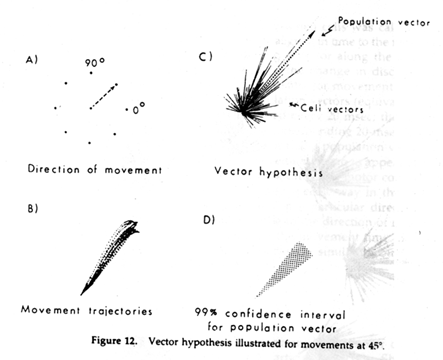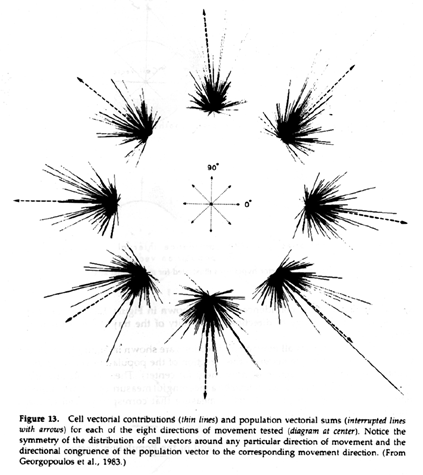
【Excerpt Note】The Representation of Movement Direction in the Motor Cortex: Single Cell and Population Studies
The chapter is published by Apostolos P. Georgopoulos, John F. Kalaska, Michael D. Crutcher, Roberto Caminiti, Joe T. Massey in 1984.
This blog is a brief summary of the chapter about neuronal mechanisms and representation of movement direction.
-
The paper discusses neuronal mechanisms in the motor cortex that may underly the control of the direction of two-dimensional arm movements.
-
They postulate that such a neuronal population may subserve all movement directions within a part of extrapersonal space as follows:
-
It is hypothesized that individual cells make a vectorial contribution of variable strength along the axis of their preferred direction, according to the change in discharge rate.
-
The vector sum of these directional contributions may represent the population code for movement direction.
-
Population vectors of various direction can be generated by varying the kind of change (increase or decrease in activity) and the magnitude of change in the discharge rate of the constituent cells; such variation is indeed observed in individual cells, as evidenced by the directional tuning curve.
-
Analysis of experimental data using these assumptions yielded population vectors whose direction was close to that of the movement.
-
Moreover, a time-course analysis showed that the very first changes in population activity preceding movement were directional and predicted the direction of the upcoming movement.
-
Two major questions are : (1) How does an individual cell relate to the direction of movement? (2) Given these individual cell relations, how could a population of cells code the direction of movements?
Cell Population Studies: Coding of Movement Direction
-
Using the single cell data, the population activity that may lead to the generation of movements in a particular direction.
-
The problem of coding movement direction.
-
The concept of the motor command for movement direction as a set of cell vectors
-
The concept of a population vector, an idea pertaining to the representation of movement direction in cell populations.
Coding of movement direction does not depend on sharply tuned cells or populations
The motor command for movement direction as a set of cell vectors and the concept of a population vector.
Individual cells would make directional contributions along the axis of their preferred direction, and these contributions from the entire population of cells would summate to produce a motor output in a unique direction in the form of a population vector. We call this the ‘vector hypothesis’ (see Georgopoulos et al., 1983).


Georgopoulos, Apostolos P., John F. Kalaska, Roberto Caminiti, and Joe T. Massey. “On the relations between the direction of two-dimensional arm movements and cell discharge in primate motor cortex.” Journal of Neuroscience 2, no. 11 (1982): 1527-1537.
Georgopoulos, Apostolos P., Roberto Caminiti, John F. Kalaska, and Joseph T. Massey. “Spatial coding of movement: a hypothesis concerning the coding of movement direction by motor cortical populations.” Exp Brain Res Suppl 7, no. 32 (1983): 336.
Georgopoulos, A.P., Kalaska, J.F. and Caminiti, R., 1985. Relations between two-dimensional arm movements and single-cell discharge in motor cortex and area 5: movement direction versus movement end point. Exp Brain Res [Suppl], 10(1), pp.5-183.
About
Brain Inspired Navigation Blog
New discovery worth spreading on brain-inspired navigation in neurorobotics and neuroscience
Recent Posts
- How locomotor development shapes hippocampal spatial coding?
- How human, animals, robots encode and recall place?
- How the brain constructs time and space and how these are related to episodic memory?
- How environmental novelty modulate rapid cortical plasticity during navigation?
- How the Hippocampal Cognitive Map Supports Flexible Navigation?
Tags
Categories
- 3D Movement
- 3D Navigation
- 3D Path Integration
- 3D Perception
- 3D SLAM
- 3D Spatial Representation
- AI Navigation
- Bio-Inspired Robotics
- Brain Inspired Localization
- Brain-Inspired Navigation
- Cognitive Map
- Cognitive Navigation
- Episodic Memory
- Excerpt Notes
- Flying Vehicle Navigation
- Goal Representation
- Insect Navigation
- Learning to Navigate
- Memory
- Neural Basis of Navigation
- Path Integration
- Path Planning
- Project
- Research Tips
- Robotic Vision
- Self-Flying Vehicles
- Semantic Memory
- Spatial Cognition
- Spatial Cognitive Computing
- Spatial Coordinate System
- Spatial Learning
- Spatial Memory
- Spatial Resoning
- Time
- Unclassified
- Visual Cortex
- Visual Cue Cells
Links
- Laboratory of Nachum Ulanovsky
- Jeffery Lab
- BatLab
- The NeuroBat Lab
- Taube Lab
- Laurens Group
- Romani Lab
- Moser Group
- O’Keefe Group
- DoellerLab
- MilfordRobotics Group
- The Space and Memory group
- Angelaki Lab
- Spatial Cognition Lab
- McNaughton Lab
- Conradt Group
- The Fiete Lab
- The Cacucci Lab
- The Burak Lab
- Knierim Lab
- Clark Spatial Navigation & Memory Lab
- Computational Memory Lab
- The Dombeck Lab
- Zugaro Lab
- Insect Robotics Group
- The Nagel Lab
- Basu Lab
- Spatial Perception and Memory lab
- The Neuroecology lab
- The Nagel Lab
- Neural Modeling and Interface Lab
- Memory and Navigation Circuits Group
- Neural Circuits and Memory Lab
- The lab of Arseny Finkelstein
- The Epstein Lab
- The Theoretical Neuroscience Lab
- Gu Lab (Spatial Navigation and Memory)
- Fisher Lab (Neural Circuits for Navigation)
- The Alexander Lab (Spatial Cognition and Memory)
- Harvey Lab (Neural Circuits for Navigation)
- Buzsáki Lab
- Brain Computation & Behavior Lab
- ……